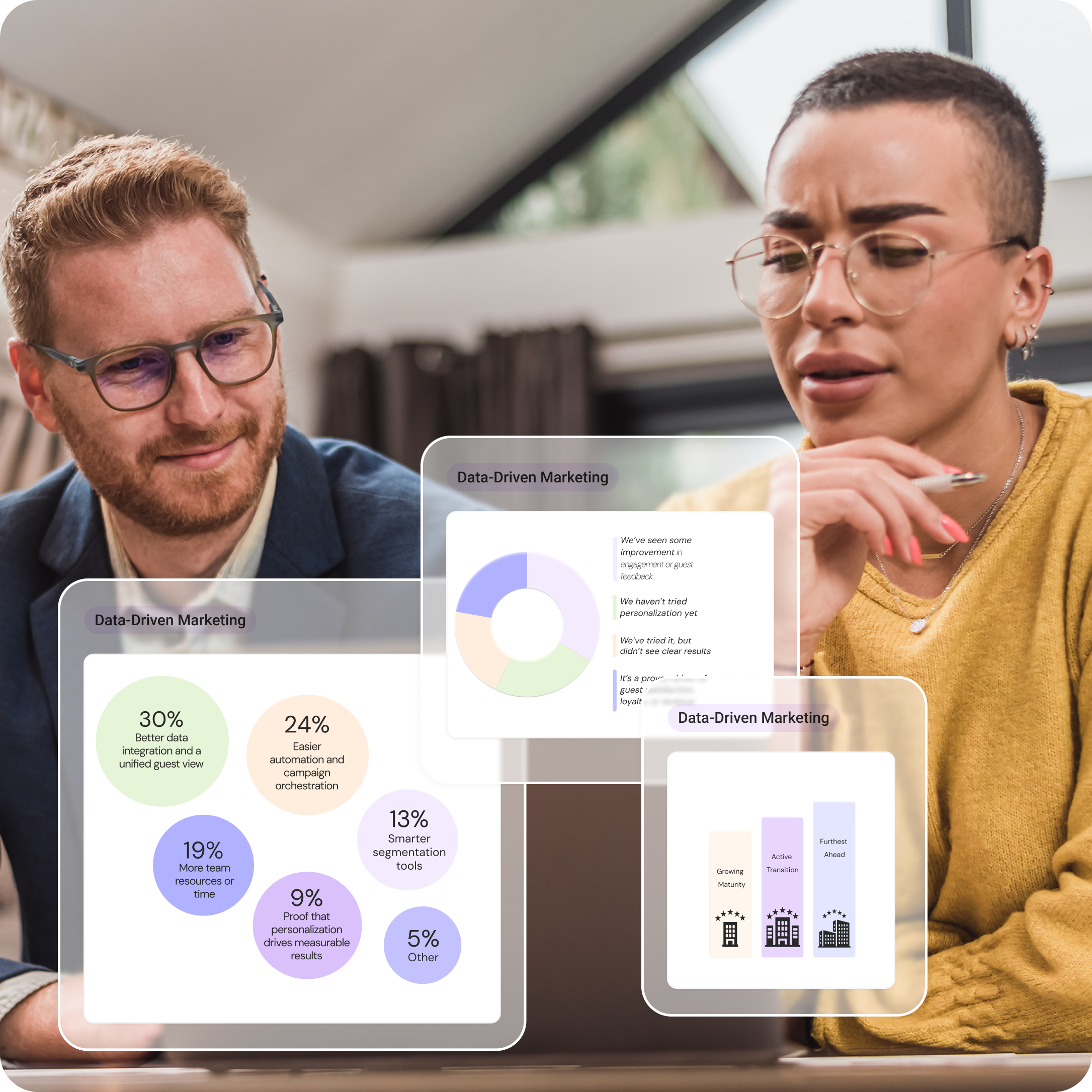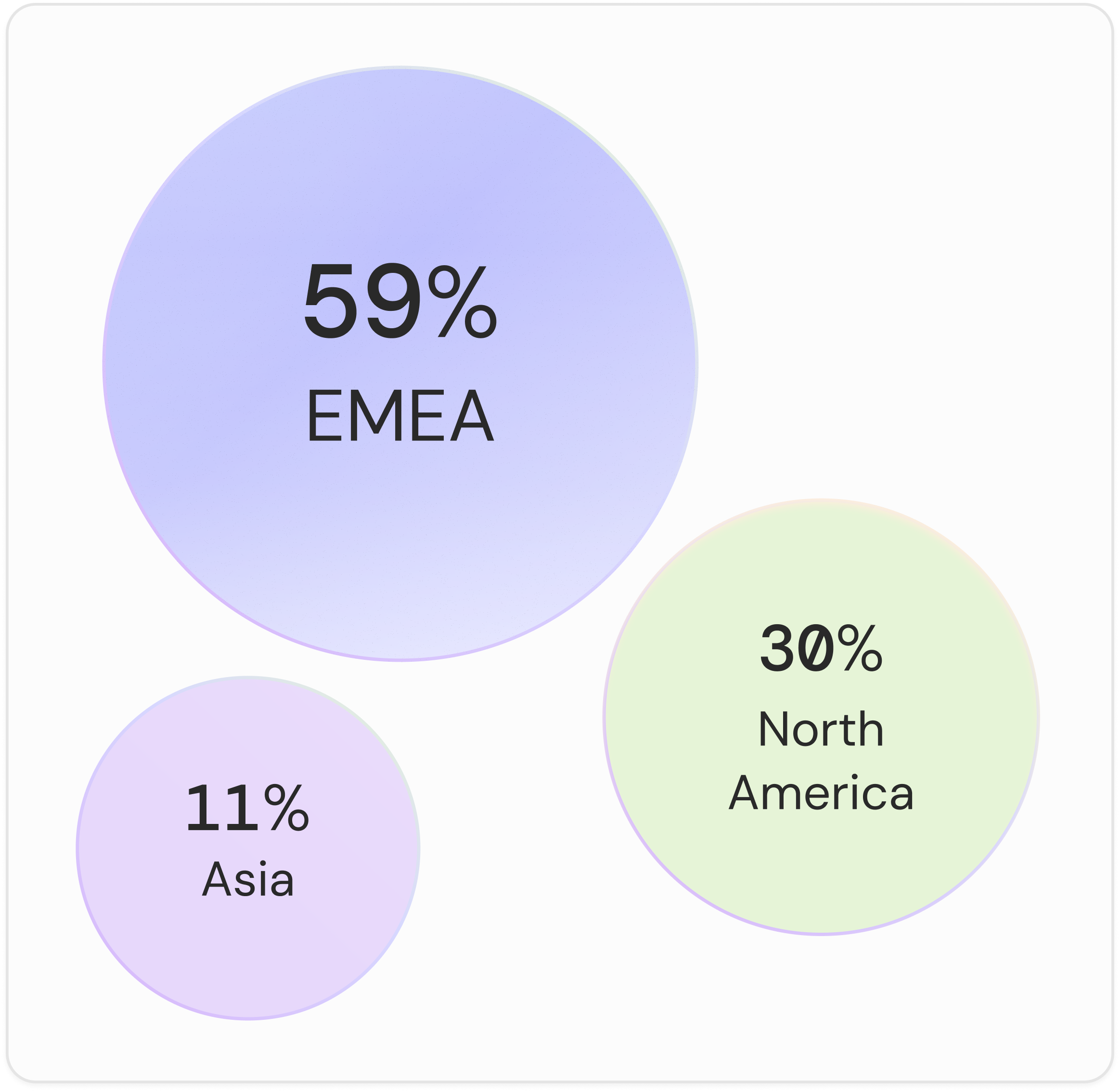
Discover how hospitality teams are (re)building marketing around data

Trött på att skriva samma meddelande varje dag? Eller uppdatera gästinformation manuellt? Med Bookboost kan du glömma det. Genom att infoga personaliseringstoken uppdateras de automatiskt med varje gästs specifika information, så att kampanjen är redo att skickas på några sekunder. Dessutom gör vår lågkodsmetod det enklare än någonsin att anpassa innehållet. Detta innebär att dina meddelanden skräddarsys direkt för varje gäst, utan någon extra ansträngning från din sida.more personalisation, more guest connection, more consistency. All while juggling fewer people, fragmented tools, and rising expectations.
At Bookboost, we believe it’s not about sending more messages, but using the right data to build stronger guest connections. Yet we kept hearing the same questions from hotel marketers and experience teams:
How are others doing it? What does “good” look like? Are we falling behind?
To find out, we launched a short, anonymous survey to take the pulse of where hotel teams stand today and where they want to go. And we received 60+ responses from professionals across the globe.

Segmentation is key to delivering personalised, relevant guest experiences. A well-prepared segmentation strategy not only makes the brand stand out but also increases satisfaction and revenue.
The data paints a clear picture: while segmentation is widely used in name, most teams haven’t moved beyond the basics.

As guest expectations rise, this gap between perceived and actual maturity becomes a missed opportunity, especially for brands that want to build relevance and loyalty. That shows up as more upsells, better reviews, and higher return rates — the metrics that matter.
We get the full picture when we break the findings down by property size:
- Smaller hotels (under 150 rooms) have made progress:
Over half rely on basic filters, but 1 in 5 now use behavioural segmentation, a sign of growing maturity.
- Mid-sized properties (150–299 rooms) are in active transition:
25% use behavioural logic, but few reach advanced.
- Large properties (300+ rooms) remain furthest ahead:
25% use advanced segmentation, though a surprising 13% still don’t segment at all.
This pattern suggests scale helps, but it’s no guarantee. Even the biggest players aren’t fully there yet.
In addition, we see that many smaller and mid-sized teams could benefit from simpler, integrated tools and clearer frameworks to evolve their strategy, without needing enterprise complexity.

If you’re only segmenting by nationality or repeat visits, you’re not alone. But that’s exactly where most brands are stuck. With so many players only grasping a basic use of filters, you have the opportunity to stand out.
The reality is that teams that invest in richer segmentation (based on booking behavior, stay history, and preferences) are more likely to see gains in engagement, conversion, and guest loyalty. The data shows the path forward: better segmentation = better outcomes.
Want to know more about how to approach segmentation? Check out this practical guide
Hospitality teams are using more channels than ever, but more channels don’t mean better marketing.
The research shows that most teams are split between two dynamics: on one side, they use only email and in the other, they have more channels but they are not integrated or automated. Both aspects lead to missed revenue and loyalty.
Shockingly, 1 in 5 hotels don’t run any marketing campaigns at all, showing that for many teams, it’s not just a tech gap, but a strategic one.
When cross-referencing the answers of this question to the property size, we found that manual multi-channel chaos is consistent across all sizes (~32–36%); however, mid-sized hotels show the clearest growth opportunity: not too small to act, not too large to be bogged down.

The truth is simple: it’s not about how many channels you use but how well you use them.
The teams that succeed are the ones creating an integrated strategy that leverages the unique characteristics of each channel and reduces the amount of manual work for their teams.
Most hotels either don’t use WhatsApp at all or limit it to check-in info, missing the chance to use it for upsells or engagement.
Only 12% include WhatsApp as part of their coordinated marketing strategy. Most teams are still manually sending on isolated tools.
It’s easy to confuse activity with strategy. Sending messages on five different platforms doesn’t mean your marketing is connected. For most teams, it’s still manual, inconsistent, and time-consuming.
In conclusion, the real barrier isn’t access to tools; it’s the lack of a connected strategy to use them meaningfully.
WhatsApp isn’t just for operations or check-in reminders. It’s a guest’s go-to channel for nearly everything. Start simple: test one message beyond check-in, like a room upgrade, a spa discount, or a review request.
That low usage shows huge untapped potential, especially in a guest-preferred, mobile-first channel. And you don’t need full automation to start seeing results. That’s where tools like Bookboost come in: not to add more work, but to connect all your guest messages into one seamless flow.
See how other hotels use WhatsApp.
When asked about guest expectations regarding communication, answers vary across teams with no real consensus.
However, relevant updates, personalised content and multi-channel communication are at the top of the list.In addition, only 6% believe guests want minimal communication.
This undercuts the old idea that “less is more” in guest messaging.
Where are you in building a coordinated guest journey? Measure your property against this benchmark.
- Only 21% of hotels orchestrate campaigns across channels
- 63% don’t use WhatsApp for marketing or use it only operationally
- 1 in 3 teams manage channels manually — a sign of process inefficiency
Guests do want to hear from you, they just expect it to be relevant, timely, and well-delivered. Not just think about who you are targeting but about what you send, where, and when.Audit one campaign this week: would you read it yourself? If not, rethink it.
For segment ideas you can activate today, check out 9 Guest audiences to target with hotel marketing campaigns
Guest data is everywhere, but for most teams, it’s a mess. The problem is not just collecting it; it’s also using it. Without clarity and trust, data becomes another bottleneck instead of a help and teams are still stuck without insights for decision-making.
What is clear is that data alone is not the power; having clarity to act on it is.
The top-line issue isn't access to data, it’s fragmented systems and the inability to utilise what teams already collect.
Two out of three hotel teams say their data is scattered or hard to act on, which means personalisation remains out of reach, no matter how much data they collect.
What’s more, only 12% feel confident they have reliable, usable, centralised guest data. That’s a low benchmark for an industry obsessed with “personalised experiences”.

It’s not about having more data; it’s about knowing what to do with it. Start by mapping where your guest data lives today. Then ask: can my team actually use this to personalise messages or improve the experience?
If not, it’s time to clean it up or connect the dots.
Not sure what is your "data problem" or how to solve it? Scan these three problems + solutions
We asked: “What would make the biggest difference in improving your marketing performance?”
The top answers weren’t more budget or more channels, they were all about operational clarity:
54% of teams say the biggest opportunity lies in operational improvements: data integration (30%) and automation (24%).
The fact that only 9% say they need proof that personalisation works shows that most are already convinced, but can’t execute it.

At this point, personalisation in hospitality could almost turn into a buzzword. Teams know it matters but many have lost faith after seeing little return.
They want to personalise and agree that calling guests by their name in a message is not enough; however, very few are the ones who are actually experimenting with personalisation beyond the basics.
Nearly half of hotels either haven’t tried personalisation, or tried and gave up. That’s a warning sign: intent is high, but execution is stuck.
For some teams, personalisation requires more effort and time than what they are willing to invest, which takes them to avoid it and stay on the sidelines.
This clearly showcases that when personalisation doesn’t go hand in hand with automation and segmentation, it can be overwhelming and time consuming.

To fully understand the answers to this question, we’ve cross-referenced it with their answers on segmentation.
Despite the hype, few teams move beyond the basics.
There’s a strong link between segmentation maturity, data usability, and personalisation impact, but most teams haven’t connected all three.
Despite widespread agreement that personalisation matters, execution is the real challenge. Even teams with good data admit they struggle to activate it.
Manual collection, disconnected tools, and lack of automation continue to block real progress.
And when asked what would most improve marketing performance, teams didn’t ask for better messages, they asked for better plumbing: unified data and automation.Until that foundation is fixed, personalisation will remain more aspiration than reality.

To dig even deeper, we’ve cross-referenced the results of personalisation with the property size. Here are the findings:
Smaller properties are often stuck in experimentation or lack the tools to personalise effectively, which may explain why 57% report no clear results.
Mid-sized hotels are making progress: 62% have seen some engagement lift, though not yet at full potential.
Larger hotels lead the way: combining advanced segmentation with automation, they report both loyalty gains and higher engagement. But even here, success isn’t universal.

Personalisation and segmentation only work when they work together; don’t treat them as separate tactics.
Start by picking one or two high-value segments (e.g. repeat guests, spa bookers) and define what would feel relevant to them. Personalisation doesn’t need to be unique to every guest, it just needs to be useful.
Then look at where automation fits. Tools like Bookboost let you add reservation details with one click using personalisation tokens, and set automation triggers that send the right message at the right time, reducing manual work for your team.
Want quick-win ideas? Try our 5 campaigns to re‑engage past guests — no fancy tech required.
The CRM of the past was built for marketers, for pushing batch campaigns, collecting email addresses, and sending post-stay surveys. But that model is breaking. Today’s guests expect relevance, timing, and consistency across email, WhatsApp, apps, and every stay.
The data confirms it:
- Only 14% of hotels use advanced segmentation
- Just 21% run multi-channel campaigns
- 66% say their data is hard to activate
- 63% underuse WhatsApp
- And only 12% have usable, centralised data
It’s not that teams don’t care. It’s that their tech isn’t built for how people actually travel, book, message, or engage.It’s time to shift from tool-first marketing to guest-first communication.